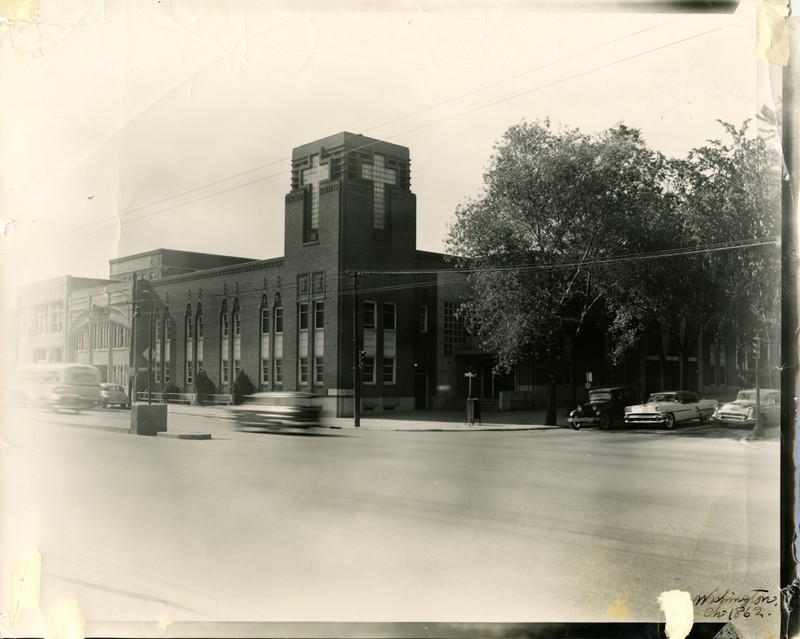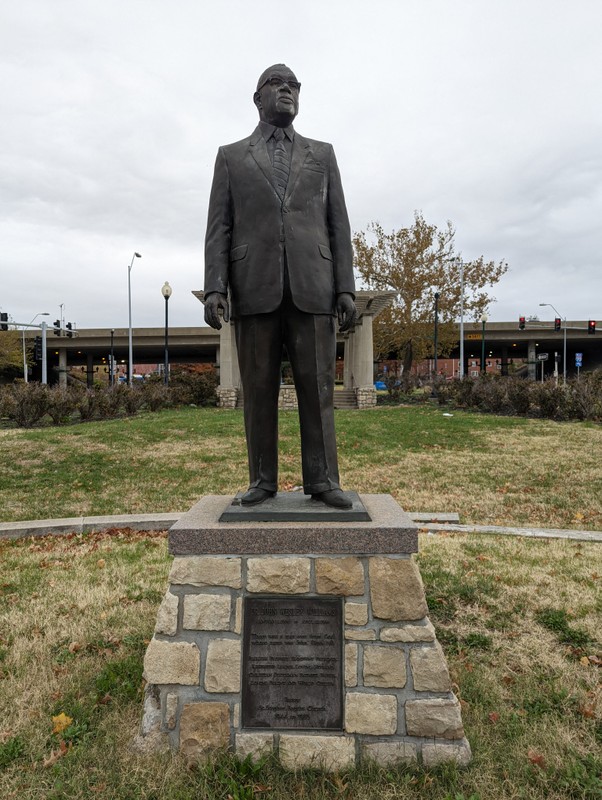St. Stephen Baptist Church and Reverend John Wesley Williams Statue
Introduction
Text-to-speech Audio
Currently located in a building on the northwest corner of Truman Road and The Paseo, St. Stephen Baptist Church has long been a fixture of the Black community in Kansas City. Founded in 1903, St. Stephen Baptist Church was created by Reverend James Wesley Hurst on a street corner in the neighborhood of Belvidere Hollow. Since its inception, the congregation has weathered fires, changes in leadership, and multiple changes of venue before arriving at its current location. After a 1938 fire consumed the previous location, the congregation purchased and remodeled a dance hall on the northwest corner of The Paseo and Truman Road, where they have remained since 1945. In 1957, Martin Luther King Jr. made the first of his six visits to Kansas City by addressing a crowd of around 750 people at this church. Across the street from the building, on an island in the middle of The Paseo, there is a statue of notable Baptist and civil rights leader Reverend John Wesley Williams, who served as pastor of St. Stephen from 1944 to 1983. Though the church has continued to experience ups and downs in recent years, the efforts of Reverend Williams and others throughout the history of the church have made sure that St. Stephen will remain a landmark of the 18th and Vine Area.
Images
Picture of St. Stephen's Baptist Church, 1955. Photographer unknown.

Picture of the Reverend John Williams Statue at The Paseo and Truman, taken November 10, 2022.

Close-up of the plaque on the front of the Reverend John Williams Statue at The Paseo and Truman, taken November 10, 2022.
![A close-up of a metal plaque set on the front of a stone brick surface. The plaque reads: DR. JOHN WESLEY WILLIAMS [new paragraph] JANUARY 2, 1906 to APRIL 22, 1988 [new paragraph] "There was a man sent from God whose name was John. " (John 1:6) [new paragraph] FEARLESS PROPHET, ELOQUENT PREACHER, RESPECTED LEADER, LOVING HUSBAND, CHRISTIAN STATESMAN, FAITHFUL PASTOR, LOVING PARENT AND WORLD CITIZEN [new paragraph] Pastor [new line] St. Stephen Baptist Church [new line]](https://storage.googleapis.com/clio-images/medium_3663_PXL_20221110_203418625.jpg)
Backstory and Context
Text-to-speech Audio
St. Stephen Baptist Church was founded in 1903 by Reverend James Wesley Hurst who began his ministry preaching on a street corner in the neighborhood of Belvidere Hollow on the corner of Independence Avenue and Charlotte Street. The small church's first permanent location was established soon after at 604 Charlotte, after members of Hurst's small but growing congregation working in the evening after they had completed their regular jobs in order to construct the building. Upon completion in 1905, the church would remain at that corner through years of growth until 1921, when the size of the congregation prompted a move to a new venue, a brick building purchased at 9th and Harrison. Around this time, Reverend Hurst passed away, and the congregation members served as lay ministers and leaders for the next two decades.
In July of 1936, Reverend Raymond J. Jordan became the second pastor of St. Stephen. On February 15, 1938, however, the 9th and Harrison location was destroyed in a fire. Members came together in support of their church once again, and Reverend Jordan acquired space at the northwest corner of The Paseo and Truman Road, which at that time was a renovated dance hall. Work began on converting the space to the needs of the congregation, an endeavor that Reverend Jordan was unable to see complete as he passed away in 1944. Later that year, Pastor John Wesley Williams became the leader of the congregation, ushering in a period of growth for St. Stephen Baptist Church.
Reverend John Wesley Williams was a renowned civil rights activist who served as pastor of this church from 1944 to 1983. Born in Houston, Texas, on January 2nd, 1906, Williams was one of twelve children born to a Baptist minister and his wife. Williams chose to follow his father in ministry, receiving an A.B., a Bachelor's of Theology, and an honorary Doctorate of Divinity from Conroe Normal and Industrial College, as well as attending the University of Kansas City (Now UMKC). Furthermore, he received an honorary Doctor of Humanities Degree from Western Baptist College in Kansas City, Missouri, and an honorary L.L.D. Degree from Union Baptist Seminary in Houston. In his early career, he preached at several churches throughout Texas, meeting his wife Marena during this time. In 1944, Reverend Williams and his wife moved to Kansas City, where he became the third pastor of St. Stephen Baptist Church.
In addition to being responsible for numerous improvements to the church itself, such as remodeling and other expansions to the building, Reverend Williams was highly active in the pursuit of community betterment. During his tenure at St. Stephen, he served as part of many committees, councils, and other groups advancing various causes in Kansas City and the world at large. Beginning in 1961, Reverend Williams founded and became President of the Greater Kansas City Baptist and Community Hospital Association, Inc., which was responsible for the creation of Dr. Martin Luther King, Jr. Memorial Hospital. In 1970, Reverend Williams was appointed to the White House Conference on Children and Youth and served a two-year term on the President's Advisory Council of Economic Opportunity. He also served in leadership roles in numerous Baptist organizations on a local, national, and international level. Through it all, Reverend Williams continued to serve as a leader for St. Stephen Baptist Church until he left the role in 1983, passing away on April 22, 1988. In 1991, a statue of Reverend Williams was erected in front of St. Stephen, on the traffic island in the middle of The Paseo. The plaque on the base commemorates Williams as a leader in his faith, his community, and his nation.
The congregation has hosted numerous civil rights leaders throughout its history, including Martin Luther King Jr.'s first visit to Kansas City on April 11, 1957. King had just been featured on the cover of Time magazine for his leadership role in the successful Montgomery Bus Boycott that began when Claudette Colvin and later Rosa Parks were arrested for challenging segregation. King utilized his sudden rise to national attention by traveling to over fifty cities in the spring and summer of that year. King visited Kansas City again in the spring of 1958, speaking at Sumner High School. Inspired by visits by national civil rights leaders, as well as the actions of Montgomery and other communities, African Americans in Kansas City began challenging segregation in small groups. In Wichita, African Americans led a successful sit-in protest against racial discrimination at the Dockhum drugstore lunch counter in the summer of 1958. This success inspired African Americans in Kansas City to organize a formal and sustained boycott of five downtown department stores that also drew the color line. By the following spring, each of the five Kansas City department stores agreed to serve all patrons at their restaurants. King would visit Kansas City four more times, including a short speech at the downtown airport between flights just months before he was assassinated.
Sources
Unknown. “About SSBC.” St. Stephen Baptist Church. Accessed November 10, 2022. https://www.ststephenbaptist.org/about-ssbc-1.
Unknown. “John Wesley Williams, Th. D. Biographical Sketch.” Kansas City, MO: The Black Archives of Mid-America, n.d.
Unknown. “St. Stephens Baptist Church.” African American Heritage Trail of Kansas City. Accessed November 10, 2022. https://aahtkc.org/ststephens.
Burnes, Brian. MLK in Kansas City, Flatland. January 18th, 2021. Accessed November 15th, 2022. https://flatlandkc.org/news-issues/mlk-in-kansas-city-martin-luther-king-day/.
Image courtesy of the Black Archives of Mid-America.
Taken by Peter Sears, Black Archives of Mid-America Archives and Digitization VISTA
Taken by Peter Sears, Black Archives of Mid-America Archives and Digitization VISTA
